Learning Tips
Calling changes
So, you think you’ve got the idea of how to ring call changes! But what about you calling some changes?
It’s true that, for many, adding another activity to ringing a bell causes problems with handling or striking or even both. A ringing medic has said that bell ringing causes intense activity in the brain which has to co-ordinate arm movements, seeing the ropes and hearing the sounds in addition to what it normally controls. You even have to remember to breathe! Now add to that the need to speak and call some changes, then it’s not surprising that things can go to pot.
 One place at a time – start simply, call yourself down or up just one place and back again. Remember that you need to be heard by your fellow ringers above the sound of the bells. You could always practise this bit in front of a mirror at home! When you’re confident with that, increase the scope by calling yourself two or three places from the starting place and back again. So far, you’ve involved your bell in the changes, but what about calling another bell to move? Could you call the bell in 5th place down to the lead position?
One place at a time – start simply, call yourself down or up just one place and back again. Remember that you need to be heard by your fellow ringers above the sound of the bells. You could always practise this bit in front of a mirror at home! When you’re confident with that, increase the scope by calling yourself two or three places from the starting place and back again. So far, you’ve involved your bell in the changes, but what about calling another bell to move? Could you call the bell in 5th place down to the lead position?
You could use pencil and paper and write down the calls, either calling up, down or by places – whichever method is preferred in your tower. However, the visual device (illustrated right), which was invented by aringer at my home tower, might help because it shows which bells are in which places as you call the changes. The inner set of numbers represent the bell places and the outer numbered door knobs represent the bells which can change places. You could replicate this model on a sheet of A4 paper with numbers 1 to 8 as fixed places and cut out some bell shapes and number them 1 to 8. So, start your plan by working out the call to swap bells 4 and 5. Your model should now show bell 5 in 4th place and bell 4 in 5th place.
Completing your plan should not be too difficult, but ask your tutor if you need help. Once you are confident of the calls to make, try it on the bells. No need to get the bells back to rounds, just call stand and cheekily ask each ringer if they know which place they are in!
Once you feel confident about moving other bells, then try calling the bells to some of the musical rows below.

Roger Coley
